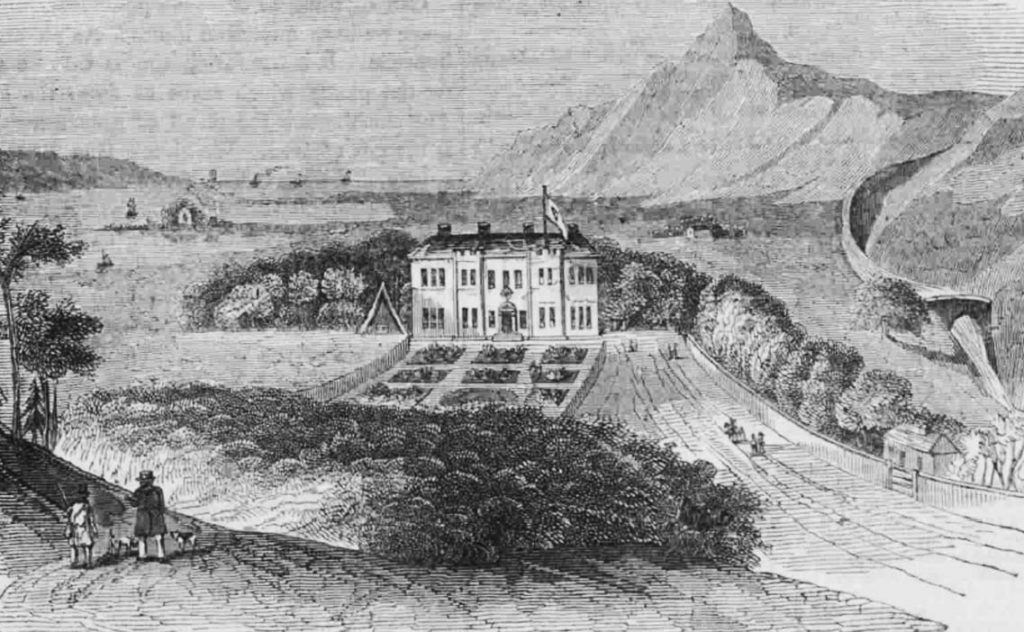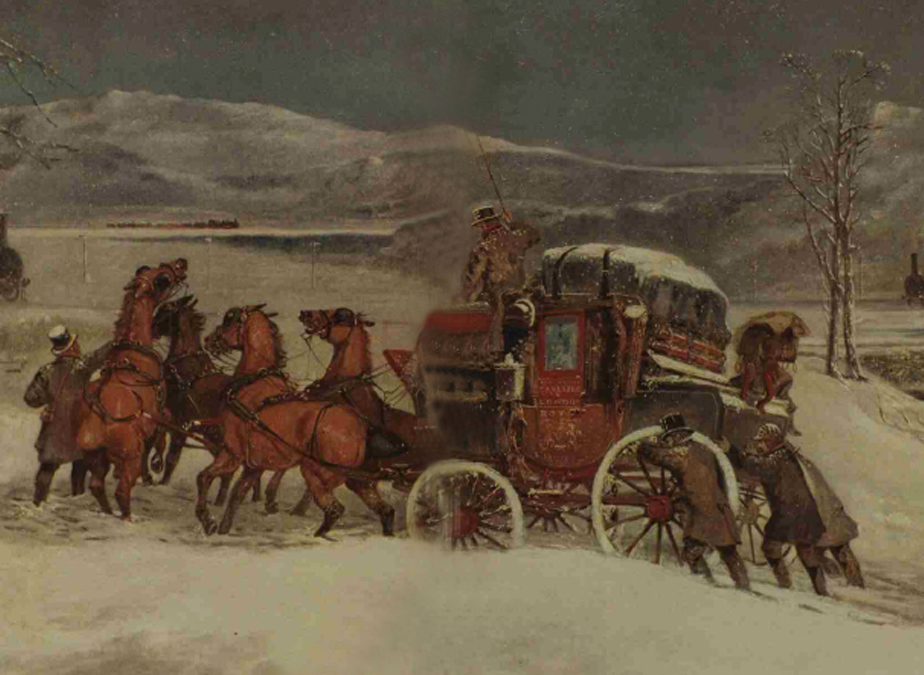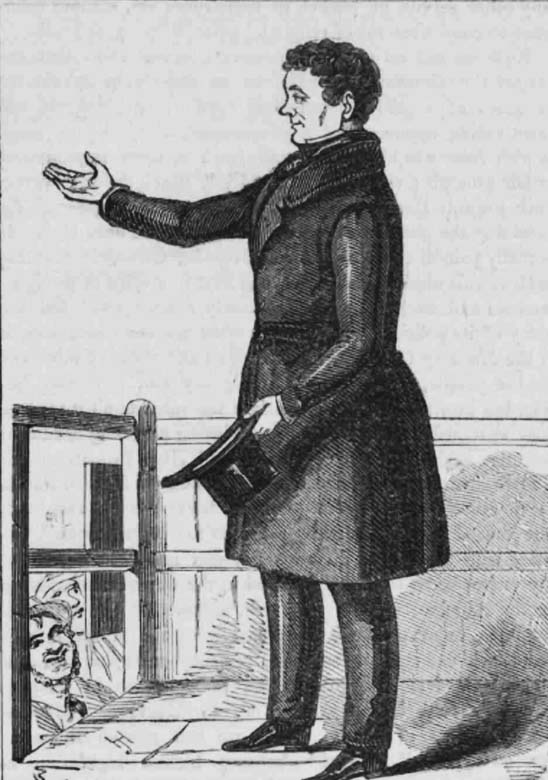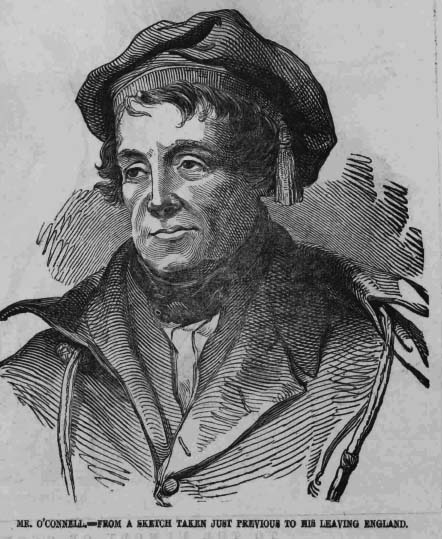If a re-enactment of Daniel O’Connell passing through Castleisland on his way home to Darrynane Abbey was staged, thousands of extras would be sought, such was the size of the crowd that turned out to greet him in December 1843 when he stopped at the town’s Brandon Arms Hotel.1
As early as 12 o’clock the country people were to be seen pouring in from all directions and continued on the increase to the time of his arrival about 4 o’clock. The commotion, the bustling, the shouting, the everything … As soon as the carriage stopped at the Brandon Arms, the air became darkened with hats.2
The Brandon Arms Hotel was situated at the top end of the town, later the premises of McElligott & Sons Ltd, established in 1870.3

The cause of the celebration was repeal, and Castleisland’s nineteenth century diarist, Robert O’Kelly, recalled seeing O’Connell on this occasion, ‘wearing his repeal cap he was.’4
Yet Daniel O’Connell was far from a rare visitor to Castleisland. From the 1820s or earlier, and up to a few years before his death in 1847, he was a beloved and familiar figure in the town as he travelled the route from his home in Darrynane in the course of his work.

In those days, travelling by stage coach on rough, uneven roads meant that seldom less than four horses were necessary for his journeys between stage coach inns, where refreshment for both passengers and horses was provided along the route from Limerick to Tralee.
On 21st January 1835, the Liberator, returning to Darrynane, travelled as far as Castleisland with stage coach drivers named Kirke and Collins, and horses named The Major, Jack, Fox and Poll.

This detailed information was gleaned from a hotel register and diary kept at Abbeyfeale by the innkeeper of the day, David D Leahy, which preserved the names of passengers, drivers, horses and fees. 5 Indeed, one of Daniel O’Connell’s letters to Leahy has come down to us:
Tralee 15 January 1836, Friday
Sir – I will be at your town about 2 o’clock on Sunday. Have four horses ready for me by two o’clock. Take care the drivers have Mass. I will not arrive until after last Mass, and will not allow any man drive me who lost Mass.
Truly Yours, Daniel O’Connell. 6

O’Connell was, in 1836, well acquainted with David Leahy for his was one of the earliest cases submitted to him for opinion in September 1805.7 Many years later, in 1824, O’Connell successfully defended David Leahy and his son Daniel when they were charged with high treason under the Insurrection Act. 8

Liberator
In the later years of his life, O’Connell received an overwhelming welcome in Castleisland during his ongoing efforts to repeal the Act of Union. It was estimated that upwards of 20,000 turned out to cheer the champion of Irish freedom as he travelled from Dublin to Tralee in the autumn of 1845. Bonfires, bands and crowds lined the roads from Limerick to Nenagh, Adare, Newcastle and Abbeyfeale. When the Liberator entered the town of Castleisland, ‘every voice was raised to cry God bless him. 9
On this occasion, O’Connell may well have addressed the crowd from the Crown Hotel, which establishment he was known to frequent.10 Indeed, any number of the town’s inns such as Bailey’s Hotel, a favoured stop-over of the celebrated William Smith O’Brien, may have played host to the distinguished guest.11

The year before the celebrations in Castleisland, O’Connell, whose demeanour was once described as ‘more like a general of Napoleon’s than an Irish Advocate’ had reckoned that he had still in him ‘15 years’ good work’.12
But this was not to be. On 15 May 1847, the great O’Connell passed away. His death caused a profound sensation, ‘each man felt the death as a family bereavement for one who loved Ireland with more than a father’s love’. It was ‘beyond all human power’ to describe the grief suffered by the nation, with ‘not an eye undimmed by tears.’
In Paradisum deducant te angeli, In tuo adventu suscipiant te martyres. May the Angels conduct thee into Paradise, May the martyrs meet thee at thy entrance.
The remains of O’Connell, the embodiment of half a century of Ireland’s most eventful history, was separated according to his wishes. His heart was buried in Rome on Monday 1 June 1847 and his body in Glasnevin, Dublin on 6 August 1847.13
It was said that never before had so many assembled in public to pay tributes of devotion and respect. During this assemblage, but for the bells of different churches, there was unbroken silence.
______________
1 He was accompanied by his son Daniel and Mrs Ffrench and her daughters and there was ‘nothing to equal the reception given him’. Darrynane or Darrinane is more commonly given as Derrynane. 2 The Brandon Arms Hotel Castleisland, named, it would seem, after Lord Brandon, was the venue selected by the Rt Hon Lord and Lady Headley and suite on 20 August 1828 and on Monday 14 September 1835. Rev William Blennerhassett, resident in England, brother of (late) Arthur Blennerhassett of Ballyseedy Esq, entertained ‘his numerous tenantry’ with a sumptuous dinner at the Brandon Arms Castleisland in September 1844. 3 Writing to the Kerryman from America in 1929, Fr Cornelius Desmond Buckley described how in O’Connell’s day, the Brandon Arms was an extensive establishment embracing the three houses occupied by Mr McElligott, Mr Buckley and Mr Crowley respectively, ‘in the latter house is a room still called O’Connell’s Pocket’. T M Donovan reaffirmed this in his 1931 History (p42) when he stated that Jeremiah Nolan (who had died some years before 1931 aged 94) had seen O’Connell passing through the town or putting up for the night at the Brandon Arms Hotel, kept by a sister of Mr Roche, Sandville, Coroner for East Kerry, in the house then owned (1931) by Mr Patrick Buckley. In June 1836, Maurice D Roche Esq, proprietor of the Brandon Arms Hotel, died from ‘brain fever’. Shortly before, on 1 February 1836, his daughter Frances Roche had married Patrick Leahy (children Catherine and John were born in 1837 and 1838 respectively). Mrs Frances Leahy, wife of Mr Patrick Leahy, Innkeeper, died in Castleisland in December 1839. Patrick Leahy, owner of the Brandon Arms Hotel, inherited from his father a valuable part of Ellis Estate in Abbeyfeale held on lease for three lives (the third life was Michael Harnett Leahy of Tullig, his nephew, son of Daniel). Further reference, ‘Remarkable Co Limerick Land Case [1871], The Voyage of the Lost Life’ Limerick Leader, 5 November 1932. The Brandon Hotel may have later been associated with Meredith; a document in the collection (IE MOD/36/36.1/36.1.1) states, ‘Where Paddy M’Elligott and family lived in Main St was known as Meredith’s Hotel’. McElligott’s Castleisland ‘EZ Living’ is today located on the Tralee Road, Castleisland. 4 IE MOD/20 The Diary of Robert O’Kelly. 5 It is not known if the register survives. Further reference, Echoes of Abbeyfeale (2015), ‘Leahy’s Inn, The Square, Abbeyfeale’, p38, which contains an image of Leahy’s Inn. David D Leahy, innkeeper, son of Daniel, had a son Daniel (born c1798) who had a son, David D Leahy (died 1891 aged 69) whose son Daniel Leahy, solicitor, died on 29 November 1917 aged 61 (to whom a memorial cross was erected in the Cistercian Graveyard, Abbeyfeale). This latter Daniel left sons Daniel, an auctioneer, and David. 6 This letter was published in the Irish Daily Independent and Nation, 8 May 1902 to which was added a note, ‘The superscription was written on the back sheet of the notepaper, which was folded in, and sealed. O’Connell’s name was written diagonally across the address in compliance with the then postal regulations, the only stamp being a date stamp bearing the mark, Tralee, 16 Jan, 1836. The address being, Mr Leahy, Innkeeper, Abbeyfeale. Daniel Leahy, solicitor, also possesses several other interesting documents embodying the advice of the great Tribune in some celebrated Limerick cases which attracted much attention in the early part of the last [nineteenth] century’. In 1928, the letter was in the possession of Daniel Leahy’s sister, Miss Elizabeth Leahy. In 1967, John B Keane read the letter in Harnett’s (formerly Leahy’s Inn) when it was in the possession of Mrs Nancy Harnett (née Leahy) wife of Batty Harnett (Limerick Leader, ‘Out in the Open’ by John B Keane, 2 September 1967). 7 The case arose when Major Ellis of Dublin purchased Abbeyfeale and adjoining townlands in 1793. Mr Leahy disputed Major Ellis’s title to part of the Fair Green which he had acquired from William Harnett. On O’Connell’s advice, Leahy maintained his title and nullified the notice to quit served on him (‘In the Old Coaching Days, An Inn Keeper’s Records of 135 Years Ago’ by J D H, Limerick Leader, 28 December 1940). J D H was James D Harnett, Abbeyfeale, a journalist for the Dublin and Cork daily papers for 60 years, who contributed many historical articles to the local press in the first half of the twentieth century. Mr Harnett, whose brother was Very Rev Dr R A Harnett, CSSp (Spiritan Order), died at his residence in Abbeyfeale on 4 January 1951 at age 80. His only son Daniel G Harnett married Miss Mary C O’Sullivan of Gortroe, Knocknagoshel in 1955. 8 Ibid. The trial took place at the Limerick Spring Assizes when the Leahys were found not guilty and discharged. 9 In Killarney, where the great meeting was held, bands struck up the air, See the Conquering Hero Comes. 10 Writing to the Kerryman from America in 1929, Fr Cornelius Desmond Buckley recalled how his mother spoke about the time O’Connell stayed at Mrs Knight’s Hotel, ‘grandmother of our own Sam’, when she was a young girl c1845. Mrs Knight’s establishment is known today as the Crown Hotel (earliest mention of the Crown Hotel is 1857). Four generations of the Knight family were associated with it. In 1836, William Knight kept an inn in Castleisland. He married Mary Cronin, ‘a Catholic’ (IE MOD/36/36.2/36.2.4) but died young, from fever, in April 1841, ‘a man of fair and irreproachable character, he has left a wife and family to lament his loss’. His widow Mary, ‘Mrs Knight’, continued there and their son Henry, innkeeper and auctioneer of Millview, married Elizabeth Leahy. Henry W Knight, described as a ‘sterling and consistent nationalist who took an active part in the national struggle in his district’ died in April 1905. Henry’s son Samuel, who died 5 July 1952, was the next landlord followed by his son, William ‘Billy’, who died on 25 August 1973. The family sold the hotel in 1995 (IE MOD/36/36.2/36.2.5). It is currently in the ownership of Joseph Browne. Maurice Murphy was associated with The Crown for a period from about 1875 to 1907. See Philip of the Hundred Cows A Folktale from Cordal (2015) for a biographical sketch of Murphy. Note: Fr Cornelius Desmond Buckley, only child of Mary Desmond and Timothy Buckley of Barrack Street, Castleisland, was professed in 1918 and subsequently ministered in New York. His mother, Mary Desmond Buckley, widow, died on 19 March 1927. Very Rev Cornelius Desmond Buckley, Brazy Point, Rockaway, New York, planned to retire to Castleisland in 1953 but died in America in the same year aged 71. He was first cousin of Mrs Nellie O’Connor, National Teacher, Castleisland and Mrs Egan, National Teacher, Scotland. 11 In January 1840, Castleisland correspondent ‘Collegiensis’ observed a Temperance Procession from the window of Leahy’s Inn, Abbeyfeale and remarked on how Mrs Bailey from the Castleisland Temperance Hotel provided refreshments. The location of Mrs Bailey’s can be mooted from a note in the collection (IE MOD/36/36.1/36.1.1) which states, ‘Where Gerald Wren lived was known as Bailey’s Hotel, a regular visitor there was William Smith O’Brien’. The Wren family sold the premises in 2001 and it was demolished in 2004. In recent times, ‘Esmay Boutique’ traded there. The property is currently empty. A plaque on the wall of this building erected by the Wren family bearing date 1835 was destroyed during renovation but an image is preserved in Castleisland Church and People by Fr K O’Shea (p21). Further reference, ‘Wrens an intriguing family history’, The Kerryman, 6 April 2006. 12 Cork Examiner, 28 Feb 1844 (sketch of O’Connell’s life). The remark about O’Connell’s appearance was made in Tour in England, Ireland, and France, in the Years 1828 and 1829; with Remarks on the Manners and Customs of the Inhabitants, and Anecdotes of distinguished Public Characters In a Series of Letters. By a German Prince (1832, 2 vols) which contains a description of the author’s visit to Darrynane (vol I, pp331-341). He observed that though O’Connell was a man of the commonalty, he was no common man and had acquired a power ‘scarcely inferior to that of the sovereign’. 13 Daniel O’Connell was born at Carhen House, Caherciveen in 1775, his father Morgan O’Connell (1739-1809) and his mother Catherine (1752-1817), daughter of John O’Mullane of Whitechurch, Co Cork. Daniel was educated at Long Island, Cork (school held by Rev Harrington at Redington); at Louvain; St Omer, and the English College of Douai. During his education at St Omer, Rev Dr Stapylton, President of the College of St Omer, wrote to Daniel’s uncle, Maurice ‘hunting cap’ O’Connell, about his progress there, ‘I have but one sentence to write about him and that is that I never was so much mistaken in my life as I shall be unless he be destined to make a remarkable figure in society’ (Illustrated London News, 29 May 1847). He subsequently entered the Middle Temple and was called to the Irish bar in 1798. It was said by Sir Jonah Barrington that O’Connell bottled his legal knowledge for his own use or that of others. It has been suggested that it was O’Connell’s attendance at a public meeting in Dublin on 24 May 1809 during which he displayed his powerful intellect that the people of Ireland looked upon him as their future leader. It has also been suggested that the grand secret by which O’Connell held his commanding position was by allowing no delegation of his power. O’Connell married Mary, daughter of Dr O’Connell of Tralee, in June 1802 and had a large family. Mary died on 31 October 1836: ‘A letter from Dr Nugent, the resident medical gentleman in attendance on Mrs O’Connell, announces the demise of that lady at the hour of half-past one o’clock on Monday morning at Darrynane Abbey’ (London Standard, 4 November 1836). The funeral was held in the chapel of Darrynane Abbey and burial in the family vault at the ruined Ahamore Abbey of the Canons Regular of St Austin (Abbey Island) situated at the end of Darrynane demesne, overlooking the Atlantic.


